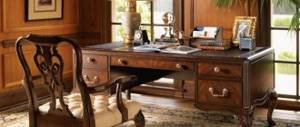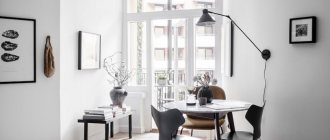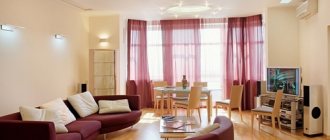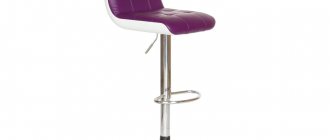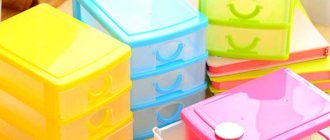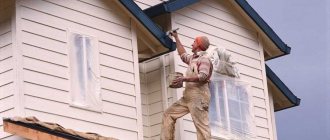So, what to buy and where to set up a workplace?
You shouldn’t put a schoolchild’s desk...
- In the kitchen. Even if it is roomy, it is not the best option. Firstly, the kitchen is a place not only for cooking, but also for constant gatherings, meetings, tea parties, clarifying problems and questions, etc. The child simply will not be able to concentrate on studying. Secondly, cuisine is food with which textbooks are completely incompatible.
- At the door. We reject this option immediately. You can’t do homework either at the door or with your back to the door. This arrangement provides psychological discomfort for the child.
- Under the 2-tier bed. Of course, you will be able to partially save square meters, but the child is guaranteed discomfort. Psychologists do not even recommend sleeping on the lower tiers - “pressure” from above does not bring any benefit. And it will also be difficult to help a child with his homework - there will be even less space for an adult.
- In the center of the room against the wall. This is a great option for mom and dad. You can immediately see what the child is doing. But for the baby himself, the option is not particularly attractive. Just like an adult, a child is much more comfortable in a private corner, where there is no need to hide notebooks from prying eyes. Personal space should be at least a little secluded.
How to arrange a workplace for a schoolchild: 12 interesting ideas
A properly organized workplace for a schoolchild is the key to his successful studies and good health. Uncomfortable chairs, a desk that is too high and a dim light bulb can lead to many problems, including. loss of vision and development of scoliosis. So, study these photo tips and create all the conditions for your child, not forgetting about aesthetics and ergonomics.
Today, a computer desk is a common and necessary thing for a student. Firstly, because a computer is necessary for doing homework (not to mention the desire of children to surf the Internet or play PC games every extra minute). And secondly, it is easier for a child to concentrate in an environment that is as close as possible to school. For a primary school student, such a modest model with a couple of drawers, as in the photo below, will be quite enough.
And the next photo will show how you can organize a large, comfortable, multifunctional workspace for a preschooler. The structure is attached to the wall and has no sharp corners. You can write with it, or draw, sculpt, play with a children's tablet, etc.
Pay attention to the interesting idea: a hanging desk in the photo below. Fits perfectly into the interior of a nursery, decorated in a modern style. And it will be much easier to clean the room.
If you think a desk would require too much space, take a look at this example. You can even order and assemble such a design yourself, and it will take up a maximum of one square meter of space.
The problem of lack of space in a children's room becomes aggravated if there is more than one child in the family. In this case, it is better to allocate part of the room for a workplace. Install sliding opaque doors, then one student will not disturb others.
You can also recommend folding and hanging structures, as in the photo below. When folded, the tabletop fits snugly against the wall, and you can get ready to work at the table within a minute.
In addition, next to the student’s workplace there must be cabinets where books and various school supplies can be stored. You can attach convenient baskets to the side of the computer desk, as in the photo below.
Cabinets above the workplace are also convenient. Just give preference to a blank facade and order a wall cabinet of such a height that it touches the ceiling. This way you will get rid of the “dusty top shelf” problem.
Scientists have long proven that bright colors contribute to the active mental development of a child. So don't be afraid of colorful desks, they will make your student think more creatively.
If you want your workplace to be less conspicuous, then order a table and cabinets in the same color as the walls.
A workspace like this for two children with original ottomans instead of a computer chair will take up even less space.
We hope that the above solutions will help you create a comfortable and beautiful corner for your child to study.
If you have more ideas, share them on the group's social media pages. Previous article: Several fresh ideas on how to decorate the walls of an apartment Next article: The most unusual and beautiful stairs: 15 interesting photos
So where should you put the table?
We choose a place based on the main conditions:
- There should be a wall behind the child's back.
- The child should immediately see everyone entering the room. Or at least when turning your head to the left (right). That is, the child should not look back to see the person entering.
- A little privacy. We create it either with the help of furniture or through a separate room. You can fence off the table with a bookcase, install it on an insulated loggia, set aside a separate cozy place in the bedroom, etc.
- A table by the window is a great option. But only if there are curtains or the ability to install the table a little to the left or right of the window, so that the bright daylight does not blind the eyes and the glare on the monitor does not interfere.
- Daylighting is a must! Is the child right-handed? This means the light should come from the left. And if you're left-handed, it's the other way around.
- Away from the TV! So that the child is not distracted from lessons and does not “squint” (this spoils vision). And away from TV radiation (safe distance - from 2 m).
Where to organize a child's workplace?
The choice of such a place is determined by several criteria.
- To prevent the child from being distracted by foreign objects and toys, the desk should be separated from the play area. This can be done using a screen, shelving or bookcase.
- It is better if the table has a natural light source. The ideal location of the table is by the window. If the child is right-handed, then the window should be on the left side, if left-handed, then on the right. It is good to place the table parallel to the window so that the child sits facing it. At the same time, the table can also be placed facing the wall, in which case it becomes possible to beautifully decorate the wall - for example, with shelves, and place on them all kinds of accessories, boxes for pencils, paints, felt-tip pens, a globe, a clock and other small little things.
- The choice of colors is also important. For a study space, it is better to choose light, pure colors. They don’t have to be boring; they can be bright ornaments or pronounced geometric shapes.
One more point that I would like to draw your attention to: what to do if you need to place two workstations in one nursery? Here are some options for arranging furniture:
- Single-row layout (two tables stand side by side in one row, which can be interrupted by furniture or aisle)
- Parallel (two tables stand opposite each other, side by side or at a distance, children can sit with their faces or backs to each other)
- L-shaped layout (one L-shaped table or two tables arranged accordingly can be used)
If you really don't have enough space...
- The table can be made folding (from the wall), but, again, taking into account the possibility of privacy.
- If there are two children , then you can connect their tables with one partition (or a bookcase for textbooks) - both space saving and privacy.
- You can build a table on a long tabletop , designer stretched along the wall above the cabinets. Part of the table top is for household items, part is for the child personally.
- Extended window sill. In tiny apartments this option is often used. The window sill is widened, lengthened, and a high comfortable chair is placed.
- Small corner table. Convenient in small spaces. Additional shelves wouldn't hurt.
- If you have some imagination, the table can be installed anywhere in the common room using space zoning (color, podium, screen, etc.). Zoning the space of a children's room for children of different sexes is an excellent design and convenience.
- Table transformer. This is also a good option, allowing you to expand the work surface and change the height of the legs according to the need.
How to organize a student’s place: tips for parents
Many modern parents may not agree that the child should have a work place at home so that he can accurately carry out his schoolwork, thus learning discipline.
Alas, this opinion is perceived by parents of the 21st century as an echo of the Soviet era. Therefore, mothers and fathers allow their children to do homework in the position and place where they themselves want. However, let's not forget that lying down or sitting on the wrong chair can have a very negative impact on the child's health. If you care about your child growing up healthy and beautiful, do everything possible to organize the student’s place correctly.
What else is useful for a well-equipped student seat in an apartment :
- the child fulfills his educational duties with interest, especially if the parents approached the choice of the design of the student’s workplace in a modern and tasteful manner;
- the quality of homework for studies increases several times;
- The child is accustomed to cleanliness, order and discipline.
What mothers and fathers who are looking for an idea on how to arrange a place for a schoolchild should remember:
- The place where the child will do his homework should be as isolated as possible from external sounds, which will only distract and confuse him. This should be a separate room with a tightly closed door.
- This room should have very good multi-sided lighting. One light source in a schoolchild's workplace , because for this reason he may have serious vision problems.
- The room in which the child will engage in educational activities must be well ventilated so that the student can breathe clean air, and not the dust that accumulates throughout the day in a poorly ventilated room.
- There should be many different shelves and cabinets behind the child’s workplace so that he can have access to the textbooks and stationery he needs at any moment.
- The room where homework needs to be done should be comfortable for the child. The atmosphere in such a room should be conducive to studying, and not discourage any desire to do homework.
Now let’s take a closer look at the main aspects of how to organize a workspace for your child:
- The place where the student will study should be decorated in pleasant colors. Psychologists say that shades of yellow and green stimulate mental activity best.
- If you have a son, then make sure that the workplace is very well lit. Otherwise, the boy will lose interest in activities too quickly and switch his attention to useless things. If you have a daughter, then in this case, make sure that all pieces of furniture and things in the workplace are tactilely pleasant.
- Separate the work area from the play area in the children's room with a small screen if your child has a separate room in which he lives. This will allow him not to be distracted by his toys during lessons, but at the same time, it will not put psychological pressure on him.
- Choose the right place to place the desk in your child’s room so that he does not feel psychological discomfort:
- You cannot place a table near the door so that the baby looks at them or sits with his back to them;
- You can’t put it under a bunk bed, because, in addition to discomfort for the child, you will also cause a lot of inconvenience to yourself when you try to help your child do his homework;
- do not place the table in the center of the children's room, because the child will feel like he is being closely watched all the time;
- You should not place a table near the TV, which will only distract your child from doing his homework;
- place the table so that there is a wall behind the student’s back, and so that he can immediately see the person who enters his room;
- It is best to make sure that the student’s workplace is located near the window, but it must be curtained.
- Choose a table that matches your child’s physiological parameters:
- the depth of the space under the table should be at least 45 cm and the width - 50 cm;
- The width of the desktop tabletop should not be less than 125 cm, and preferably, it should be made of natural, environmentally friendly material (note that a computer and a shelf with books must fit on the table - for this you can purchase special stands that will save space on the desktop table);
- the edge of the tabletop should rest against the child’s chest, and it should be comfortable for the student to place his elbows on the table.
- It is desirable that the desk has built-in special drawers where the student can put his stationery;
- if the table is too high for your child, buy a special footrest so that they rest on it (this is very important to avoid problems with the spine).
- Choose a quality chair or armchair for your student:
- the child should be comfortable and soft on the seat (if he has a hard seat, use an additional pillow);
- It is best if the chair is orthopedic and stable;
- the back of the chair or stool should be flat so that the child can lean on it freely;
- Make sure that the seat is made of high quality natural material.
- The height of the table and chair must match each other. We have attached a table of parameters that must be adhered to for you below:
- Pay special attention to the quality of lighting in your child’s workplace:
- The light should be very natural, so you need to choose non-energy-saving lamps with yellow light. Halogen and fluorescent ones are not suitable for this.
- In addition to lighting on the desktop, there should also be general lighting, which should be provided by a chandelier.
- The table lamp should have the simplest and safest design possible so that your child does not want to take it apart at some point. However, choose a model that allows you to change the lighting angle.
What do experts say on this topic?
- Required space under the table: width - from 50 cm, depth - from 45 cm.
- Working surface space: width - 125-160 cm, depth - from 60-70 cm.
- The edge of the table is at the level of the child's chest. When working at a table, the child’s legs should be at right angles, the baby should lean on the table with his elbows, and his knees should not rest against the tabletop from below.
- If the table is too high , choose a suitable chair.
- The legs need support - they should not dangle in the air. Don't forget the footrest.
- The table material is exclusively environmentally friendly (including the paint and varnish surface).
Selection and arrangement of furniture when organizing a student’s workplace
First of all, when organizing a workplace, you should consider the correct arrangement of furniture. Most often, parents try to arrange the furniture so that the table is near the window.
This has its advantages:
- maximum use of daylight;
- the child can be distracted by what is happening outside the window and take a breath between writing hooks and sticks.
When arranging furniture near the window, it is worth considering the working hand. By the age of going to school, parents already know which hand the child has the dominant hand. If the child writes with his left hand, set the table so that daylight falls on the right, i.e. We place the table on the left wall of the room. For right-handed people, on the contrary, on the right side.
When sitting at a desk, the child should maintain an ergonomic body position. When sitting slouched for a long time, the muscles of the back and neck will quickly get tired, and headaches will begin. It is worth considering the option of a transforming table, i.e. furniture that grows with the child, because... its height is adjustable according to the child's height. Material: wood or high-quality plastic. Please note: glue residues, chips, and wooden burrs are a sign of a low-quality product.
You need to choose the right chair for the table. Preparing lessons is not a matter of three minutes. It happens that children spend several hours studying. A comfortable seat and backrest with a curve for the lumbar region, to which the student’s back fits snugly, is an excellent choice. The presence of armrests is not necessary: if the child is positioned correctly at the table, his elbows are located on the table.
An office chair is a good choice. The only drawback is that it rotates, and it is difficult for fidgets to control their body position. But in some models this function is blocked. The chair should not be too deep. The ideal width of the seat is from the tailbone and just short of the child’s knees.
The height of the furniture should be adjusted so that the table is at the level of the solar plexus, the knees are bent at right angles and the feet are on the floor. If the height of the table cannot be adjusted, we adjust the correct position of the child at the table using the height of the chair. Don't be alarmed if your child can't reach the floor with his feet, a footrest will come to the rescue.
Size table:
- With a height of 100-115 cm: table height - 46 cm, chair height - 26 cm.
- With a height of 115-130 cm: table height - 52 cm, chair height - 30 cm.
- With a height of 130 - 145 cm: table height - 58 cm, chair height - 34 cm.
- With a height of 145 - 160 cm: table height - 64 cm, chair height - 38 cm.
- With a height of 160 - 175 cm: table height - 70 cm, chair height - 42 cm.
- If you are over 175 cm tall: table height - 76 cm, chair height - 46 cm.
Comfortable table, table sizes for a first grader
In order for the table to be comfortable, you definitely need to decide on the size. The table must correspond to the physical characteristics of the child. So, for a first-grader with a height of 100-120 cm, a table height of 53 cm is suitable.
If your child has grown to 130 cm for school, then the table needs 58 cm. For a child above 130 cm, calculate the height of the table as follows: for every 10 cm of height + 5 cm (from 58 cm). The numbers are good, but it’s better, so to speak, to “try on” a table for a child before buying.
How to determine the comfort of furniture? Quite simple actually.
- The distance from the tabletop to the knees is approximately 15-17 cm.
- Place your child next to the table. At the correct table height for a child, the elbows are located 5 cm below the tabletop. It should be opposite the solar plexus.
Choosing a chair!
What to buy - a chair or an armchair?
Of course, the chair is much more comfortable: it is adjustable in height and backrest angle, and some models even have footrests.
But the selection criteria, regardless of whether it is a chair or an armchair, will be the same:
- The seat should be comfortable and soft. If it's a chair, use a thin pillow.
- If it is a chair, choose a piece of furniture with orthopedic functions.
- High stability.
- A flat and firm back, against which the child’s back should be pressed tightly (this takes the load off the spine).
- The materials are environmentally friendly. Check the quality certificate!
Schoolchild's chair, choosing the right chair for a first-grader
When purchasing a table, you will also need to look in the chairs department.
You also need to take the choice of a chair seriously. A properly selected chair will also help maintain posture and vision, and prevent overwork.
The first criterion is quality. Don't forget that small children are very active, even while sitting. Therefore, in order for the student not to feel discomfort, the chair must be of high quality and wear-resistant.
The next criterion is height. It is better to choose chairs that can be adjusted. This chair will grow with your child.
You shouldn't buy a computer chair right away. Its backrest is harmful to children's backs.
The best option would be a chair without a back with rounded shapes. The right chair for a first-grader should have a depth of about 50 cm. This depth allows you not to strain your back.
Is a computer needed on a child's desktop?
Today, elementary schools already practice computer science classes, and already from the 3rd grade, many children even create simple presentations on their own on a PC, but in the first 2 years you definitely won’t need a computer.
Whether or not to install a PC for a child depends on the parents.
But remember that the maximum time for practicing on it at the age of a first-grader is half an hour a day!
If you still decide that your child should have his own computer, then let it be a laptop that can be taken out for a certain time and then put away again.
You should not leave it on the table on a permanent basis - the child will be distracted from studying. The temptation to play another game or check messages on social networks is too great.
Where to start?
First, you need to identify a number of rules that you will subsequently follow:
Firstly, refuse to purchase games or other interior items for your child’s room, which will only clutter up the free space and not allow comfortable movement.
Moreover, psychologists have found that a child quickly gets tired and even depressed by a large number of toys; he cannot concentrate on any of them, which can subsequently affect frequent irritability and moodiness.
Secondly, avoid furniture with sharp corners. Over the years, a child may develop a closed movement and plasticity may be impaired; he will always be afraid of touching something during activity.
Thirdly, do not buy super expensive furniture in the hope that it will serve you faithfully for many years.
After all, the most important thing is that the child has a feeling of comfort and joy from being in his room. And with age, he will also take part with you in choosing a particular environment.
Main criteria:
- The light should be as close to natural as possible. We choose a lamp with yellow light - an incandescent lamp of 60-80 watts. Don’t skimp on your child’s vision—energy-saving white light bulbs won’t do! Halogen light bulbs are too bright for a baby - they are not worth purchasing.
- Luminescent ones are also not an option - their invisible flicker tires the eyesight.
- In addition to your own lamp, naturally, there must also be general lighting of the room , otherwise the child’s vision will deteriorate very quickly. This could be a chandelier, sconce, or additional lamps.
- Design of a child's table lamp. Basic requirements: minimum elements. The child should not have the desire to disassemble the lamp or play with it. Therefore, lamps in the form of toys are not suitable for first-graders. Various decorative elements in the form of crystal, etc. are also undesirable. They create glare, which negatively affects vision.
- Safety. The lamp must be shockproof. So that the child, while playing, does not accidentally break it and get hurt.
- The lamp must have a lampshade (preferably yellow or green) so that the light does not blind the child.
- It is desirable that the design of the lamp allows you to change its angle , and the base of the lamp is carefully secured to the table using a bracket.
Choosing a desktop for a nursery
When you choose a desk for your child, remember that it should be comfortable and functional for him, in addition, the location of the desk in the room (relative to daylight, etc.) is extremely important. Pay attention to its environmental friendliness and safety. These are very significant characteristics, unlike, say, those that are directly related to the appearance and design of the table. It’s not necessary to choose the “coolest” table from a fashion designer, or some incredible color or pattern (which can quickly tire a child) - it’s better to “throw your energy” into a not so prestigious, but much more comfortable and affordable purchase .
Photos of the best options for a home workplace for a schoolchild
How did you arrange a workplace for your student? Share your tips in the comments below!
